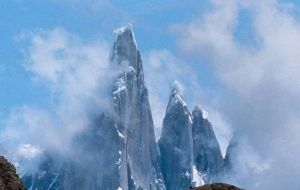MercoPress. South Atlantic News Agency
Weather anomalies strike the Andean region
 Andes glaciers
Andes glaciers A heat wave is causing a string of forest fires in Colombia, in the Andes glaciers are melting, in Bolivia rainfall is double the average and in the whole Andean region climatic anomalies are forcing drastic measures to contain further damage.
Bolivia so far this year has recorded torrential rainfall and historic maximum temperatures as a direct consequence of El Niño phenomenon. "Pluvial records and anomalies have been 70% above normal in December and January", said Bolivia's head of the national weather service Hubert Gallardo. Last Sunday the country experienced record maximum temperatures above the previous marks of 1998. In Sucre the maximum was pushed to 29 from 28.5 degrees; in Cochabamba temperature rose to 33.5 degrees and the town of Tarapaya, province of Postosí registered the greatest surge, 3,3 degrees reaching an all time record of 31,2. Weather conditions so far have caused the death of 17 people and thousands had to be evacuated because of flush rains and flooding. In Colombia the government ordered the closure of 17 national parks and Civil Defense is in maximum alert to counter the wave of forest fires that have devastated 3.000 hectares of woods and pastures, revealed Colonel Eugenio Alarcon, head of disasters prevention from Civil Defense. In the vicinity of the capital Bogotá ten fires erupted and are being tackled with helicopters spreading water trying to avoid the flames from reaching the populated outskirts of the city. The high temperatures during the day, reaching 30 degrees Celsius and helping to trigger fires contrast with the extreme cold of the nights with up to 8 degrees below zero, which has also destroyed crops. The Colombian government has promised aid to farmers in an attempt to avoid farm hands from ending unemployed. In Ecuador the meteorological service also reported "extremely high temperatures for this time of the year when usually heavy rains prevail". However in Peru, the intensity of El Niño was considered "normal" by Peruvian weather authorities, in spite of heavy rain and flooding which has killed 11 people, a similar number of disappeared, and left over 7.000 homeless. Venezuelan President Hugo Chavez has blamed global warming for the weather anomalies which have caused innumerable flooding and landslides during the last decade, such as those of 1999 which killed and buried thousands particularly in the hills surrounding the capital Caracas. But perhaps the most disturbing signal that climate is changing, and rapidly, can be appreciated in the perpetual snows of the Andes. In the last three years the snow covered peaks are melting at an annual rate of 25 meters, ten meters faster than five years ago. Something similar can be said of the majestic white peaks of Ecuador and the Chacaltaya glacier in Bolivia which looks to disappear




Top Comments
Disclaimer & comment rulesCommenting for this story is now closed.
If you have a Facebook account, become a fan and comment on our Facebook Page!